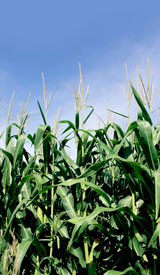June 11, 2007
Contacts: Cornell University: Dr. Donald R. Viands, 607-255-3081;
Julie L. Hansen, 607-255-5043; Hilary Mayton, cell: 607-327-0044
Note: Plantings are planned for Wednesday, June 13 in Madrid, NY at the
Lee farm
North Country Farmers Switching to Grass as Energy, Livestock Feed
Crop
Cornell University researchers will soon sow a new field trial of
switchgrass and other grass species at Tom Lee�s farm in Madrid, NY. The
researchers are interested in the potential of the grasses to produce
bioenergy. Lee is interested in the potential of the grasses as a crop
he can raise as he transitions away from dairy farming. The Northern New
York Agricultural Development Program, the New York Farm Viability
Institute, and Cornell Agricultural Experiment Station in Ithaca are
funding grass research trials in St. Lawrence and Jefferson counties in
2007 and in Eastern NNY in 2008.
�Our first trials here in 2000 were in response to a company in Quebec
wanted 10,000 acres of switchgrass to pelletize and send to France as a
fuel source. A plant in Cornwall was shifting to switchgrass to replace
pulpwood to produce paper, and town governments in the Adirondack region
were looking to cap landfills with switchgrass,� says Cornell
Cooperative Extension of St. Lawrence County Field Crop Educator Peter
M. Barney. �We needed to know if the crop could survive under Northern
New York growing conditions.�
Switchgrass is a warm season grass that the United States Department of
Energy has identified as the perennial grass with the most promise as a
biomass crop for much of the U.S.
For Madrid farmer Tom Lee, switchgrass represents a crop he might grow
as he transitions away from raising dairy heifers. He stopped milking
cows after 21 years in 1997 to raise heifers. Lee says if the grass
trial goes well, he will take a conservative approach to work gradually
away from the heifers and into the crop over the next five years.
�Hearing about switchgrass at some crop meetings intriqued me. Cornell
looking for land for a field trial gives me a perfect opportunity to try
growing a new crop with their guidance,� Lee
says. �If the grass grows well here, I would likely plant ten acres next
year to start,� Lee says.
Beef producer Mark Rinehart of Richville has grown nine acres of
switchgrass on his clay soils since 2003 to feed his beef cows. He
harvests once a year and says the key is not cutting the crop too low.
�The beef animals love switchgrass. It provides them with a physical
energy source similar to feeding corn,� Rinehart says. �I would love to
see switchgrass catch on as an energy crop to produce heat in this area,
but the industry has to catch up first. It is very difficult to get the
grass pelletized.�
Rinehart, who works with the Partners for Wildlife program of the US
Fish and Wildlife Service, does not harvest his crop until after July 15
when the birds that have nested in the switchgrass cover have fledged
their young.
Research Team Says Grass Has More Potential than Corn for Ethanol
Production
Dr. Donald R. Viands, Research Associate Julie L. Hansen and Extension
Associate Hilary Mayton � all of the Cornell University Plant Breeding
and Genetics Department - are the 2007-08 grasses-for-energy project
leaders. A plant pathologist, entomologist, weed scientist, crop and
nutrient management specialists, and staff at the USDA Big Flats Plant
Materials Center in Corning, NY, will assess the entire feedstock
production system for the grasses. An economist will analyze 2008 field
samples data for the grasses� income potential.
Viands says, �Grass and legume crops potentially provide more economical
and environmentally sustainable feedstocks than corn for ethanol
production. Their perennial growth eliminates the costs associated with
an annual crop and they are environmentally more sustainable because of
their lower nutrient inputs and because their root system holds the soil
against erosion and they require less land disturbance as they grow.�
Cornell Cooperative Extension of Jefferson County Field Crops Educator
Michael E. Hunter says the potential for switchgrass pellets to produce
heat was demonstrated at the 2007 Spring Home Show at the Jefferson
County Fairgrounds. Sundance Pool and Leisure of Watertown successfully
burned switchgrass pellets in a biomass stove at their show display.
�The agricultural industry is also taking steps to develop the
infrastructure needed to support grass fuel production. For example, a
Pennsylvania company is about to debut a tractor-driven hay pelletizer
that could encourage additional interest in on-farm development of the
grass crops. At an expected cost of up to $80,000 for the new machine,
the potential may exist for a custom service that would go from farm to
farm to pelletize the grasses,� Hunter says.
Switchgrass Proves Suited to NNY Climate
Barney says trials have shown the upland variety of switchgrass to be
more suited to the Northern New York climate than the lowland varieties.
�Switchgrass prefers well-drained loam and sandy loam soils. It will
grow on soils with a relatively wide range of pH, but a pH of 6.5 is
optimal, and to establish the crop we recommend not applying manure or
nitrogen in the first-year to reduce weed pressure on the new crop,�
Barney says.
Seedbeds need to be properly prepared for a first crop of switchgrass to
enhance seed-to-soil contact. Barney says. �One to three seedlings per
square foot at the end of the first year is considered a successful
start for a new crop of switchgrass.�
An �Establishing and Managing Switchgrass� Agronomy Fact Sheet compiled
by Barney, graduate student Joe Lawrence and Cornell Crop and Soil
Sciences Professors Dr. Jerry H. Cherney and Dr. Quirine Ketterings,
says seeding should take place after the soil temperature reaches 60
degrees Fahrenheit or within two weeks of the recommended corn planting
dates for one�s area. Seeding should not take place after June due to
risk of winterkill.
Seeding rates should be based on pure live seed per acre recommendations
and dormancy percentages. Depth for seeding by conventional and no-till
methods is one-quarter to one-half inch with the shallower depth for
heavier soils. A slightly higher seeding rate is recommended for no-till
and frost seedings.
Properly labeled herbicides and mowing just above the height of the
switchgrass are recommended for weed control. Chemical weed control can
be used in the fall prior to establishment, pre-plant and post-plant.
Hormone herbicides should be avoided.
Soil testing should be conducted every three years to assess the
nutrient status of the soil and to guide applications of lime,
phosphorus and potassium. When switchgrass is managed as a biomass crop
under a single cut system, nitrogen fertilizer needs are lower than when
it is managed under a multiple-cut forage system. For a single-cut
biomass planting after the first year, 50 to 75 lbs of nitrogen per acre
per year is recommended.
Manure can be applied in place of commercial fertilizers, however, the
amount of manure that should be applied may be limited for
biomass-for-combustion plantings because nutrient removal by that type
of planting is minimized.
�For stand longevity, we recommend not harvesting the crop the first
year. In later years, the timing of harvest for a single-cut system is
at a six-inch stubble height to assist with plant recovery. This is
different than for a spring mowing of a grass crop overwintered for
harvest as livestock forage,� Barney says.
Among the funders of the grasses-as-energy project is the Northern New
York Agricultural Development Program, a farmer-driven research,
education and outreach program funding projects that take place on
regional farms, at the research farms in Northern New York. NNYADP board
member and beef farmer Don Holman says, �The opportunities for
grass-based agriculture in Northern New York are exploding � from
grass-fed livestock production to growing grasses to power our equipment
and farms, heat our homes, and sell. Testing under our local climate and
growing conditions provides valuable data for farmers to factor into our
decision-making.�
To learn more about the Northern New York Agricultural Development
Program and its projects, go online to
www.nnyagdev.org For a copy of the Cornell fact sheet on
growing switchgrass, contact your local Cornell Cooperative Extension
office or go online to
http://nmsp.css.cornell.edu/publications/factsheets/factsheet20.pdf



